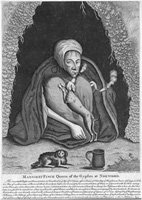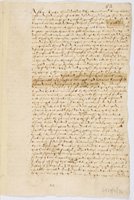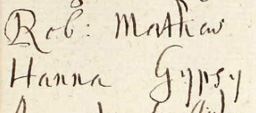 Gypsies, described originally as 'Egyptians' in medieval France, are recorded as being in eastern Europe by the 1400s and in England by the early 1500s. England saw the arrival of travelling communities in the early 16th century following a series of expulsions from countries in mainland Europe, as the development of nation states and the expansion of the Ottoman Empire increased the status of these communities as 'outsiders'. In 1490, an edict was passed in Spain that began hundreds of years of suppression for Gypsies. They were banished from Germany in 1500 by the Holy Roman Emperor, from France in 1504 by Louis the Twelfth (returning to the country was punishable by death), and in 1525 they were expelled from the Low Countries. Reasons given for their expulsion included being traitors to Christendom, practitioners of witchcraft and carriers of the plague! With nowhere to go and with England across the channel, migration to this country became an obvious solution.
Gypsies, described originally as 'Egyptians' in medieval France, are recorded as being in eastern Europe by the 1400s and in England by the early 1500s. England saw the arrival of travelling communities in the early 16th century following a series of expulsions from countries in mainland Europe, as the development of nation states and the expansion of the Ottoman Empire increased the status of these communities as 'outsiders'. In 1490, an edict was passed in Spain that began hundreds of years of suppression for Gypsies. They were banished from Germany in 1500 by the Holy Roman Emperor, from France in 1504 by Louis the Twelfth (returning to the country was punishable by death), and in 1525 they were expelled from the Low Countries. Reasons given for their expulsion included being traitors to Christendom, practitioners of witchcraft and carriers of the plague! With nowhere to go and with England across the channel, migration to this country became an obvious solution.
It is not known for certain how many Gypsies travelled to England in the early years of the 16th century but, regardless, this led Henry the Eighth's Ministers to pass the so-called Egyptians Act in 1530 with the aim of removing all such people from the kingdom. The Act condemned the 'Egyptians', accusing them of "using great subtlety and crafty means to deceive people... palmistry, defrauding people of money, felonies..".
 A series of letters and instructions in the archives of the More-Molyneux family of Loseley Park, now held by Surrey History Centre, indicate that Gypsies were considered a threat during the reign of Elizabeth I. A number of letters, written to the Justices of the Peace and Surrey's Sheriff in 1569, request them to take action against Gypsies. References in these documents link 'Egyptians' with 'rogues', 'masterless men', 'tinkers' and 'proctors'. It appears that they were also pursued because their lives "are an abomination in the sight of God" and they were feared because they were "dangerous to the common weal".
A series of letters and instructions in the archives of the More-Molyneux family of Loseley Park, now held by Surrey History Centre, indicate that Gypsies were considered a threat during the reign of Elizabeth I. A number of letters, written to the Justices of the Peace and Surrey's Sheriff in 1569, request them to take action against Gypsies. References in these documents link 'Egyptians' with 'rogues', 'masterless men', 'tinkers' and 'proctors'. It appears that they were also pursued because their lives "are an abomination in the sight of God" and they were feared because they were "dangerous to the common weal".
Loseley manuscripts aside, identifying Gypsies in historical records is incredibly difficult. References to 'stranger', 'wanderer', 'vagrant' and 'traveller' in the early Surrey parish registers do not conclusively prove that these people were Gypsies but they could suggest those living an itinerant lifestyle.
 Among the earliest recordings of possible Gypsies in the county are three entries recorded in the parish register of St. Andrew's Church in Farnham. The baptism entry of 'Margarett Flaggott a strangers child' on 1 June 1564, and burials of 'John Kymber a stranger' on 23 February 1550 and 'Richard a stranger' on 10 May 1552 are among the earliest recorded in Surrey. The first specific reference to 'gypsy' is a burial entry for 'Hanna Gypsy' at St. Nicholas' Church in Sutton on 20 August 1707, although it is uncertain as to whether this was part of her name or simply defined who she was.
Among the earliest recordings of possible Gypsies in the county are three entries recorded in the parish register of St. Andrew's Church in Farnham. The baptism entry of 'Margarett Flaggott a strangers child' on 1 June 1564, and burials of 'John Kymber a stranger' on 23 February 1550 and 'Richard a stranger' on 10 May 1552 are among the earliest recorded in Surrey. The first specific reference to 'gypsy' is a burial entry for 'Hanna Gypsy' at St. Nicholas' Church in Sutton on 20 August 1707, although it is uncertain as to whether this was part of her name or simply defined who she was.
Depictions of Gypsies in this early period are incredibly rare. The earliest we have found is a 1742 engraving of Margaret Finch, Queen of the Gypsies, at Norwood (reference 4348/1/9/2).
June is Gypsy, Roma and Traveller History Month. Find out more about the history of the community in Surrey on the Exploring Surrey's Past website, including a family history guide and bibliography.
Original Research by Alan Wright, Surrey Heritage Volunteer.
See also
Tracing Gypsy Romany and Traveller Ancestors at Surrey History Centre
Images
Select image to view a larger version.
- Engraving of Margaret Finch, Queen of the Gypsies, at Norwood (reference 4348/1/9/2)
- Letter from the Privy Council to William More, 1 March 1569, ordering the arrest of 'Egyptians'. Taken from the Loseley letters (reference 6729/11/52)
- Burial record for Hanna Gypsy (burial register now with Sutton Heritage)

